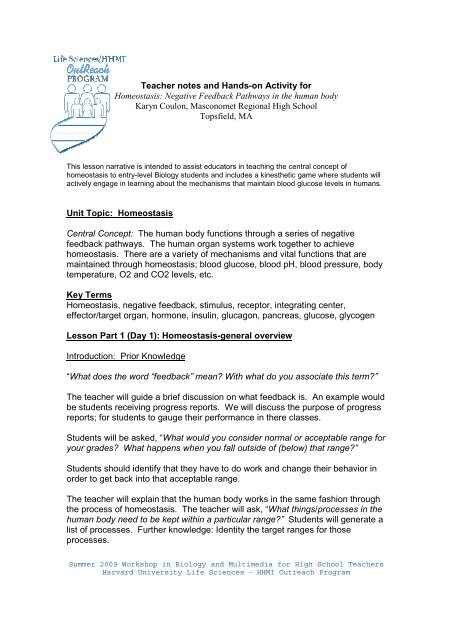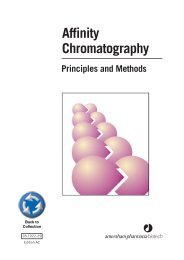Teacher notes and Hands-on Activity for Homeostasis: Negative ...
Teacher notes and Hands-on Activity for Homeostasis: Negative ...
Teacher notes and Hands-on Activity for Homeostasis: Negative ...
- No tags were found...
Create successful ePaper yourself
Turn your PDF publications into a flip-book with our unique Google optimized e-Paper software.
<str<strong>on</strong>g>Teacher</str<strong>on</strong>g> <str<strong>on</strong>g>notes</str<strong>on</strong>g> <str<strong>on</strong>g>and</str<strong>on</strong>g> H<str<strong>on</strong>g>and</str<strong>on</strong>g>s-<strong>on</strong> <strong>Activity</strong> <strong>for</strong><strong>Homeostasis</strong>: <strong>Negative</strong> Feedback Pathways in the human bodyKaryn Coul<strong>on</strong>, Masc<strong>on</strong>omet Regi<strong>on</strong>al High SchoolTopsfield, MAThis less<strong>on</strong> narrative is intended to assist educators in teaching the central c<strong>on</strong>cept ofhomeostasis to entry-level Biology students <str<strong>on</strong>g>and</str<strong>on</strong>g> includes a kinesthetic game where students willactively engage in learning about the mechanisms that maintain blood glucose levels in humans.Unit Topic: <strong>Homeostasis</strong>Central C<strong>on</strong>cept: The human body functi<strong>on</strong>s through a series of negativefeedback pathways. The human organ systems work together to achievehomeostasis. There are a variety of mechanisms <str<strong>on</strong>g>and</str<strong>on</strong>g> vital functi<strong>on</strong>s that aremaintained through homeostasis; blood glucose, blood pH, blood pressure, bodytemperature, O2 <str<strong>on</strong>g>and</str<strong>on</strong>g> CO2 levels, etc.Key Terms<strong>Homeostasis</strong>, negative feedback, stimulus, receptor, integrating center,effector/target organ, horm<strong>on</strong>e, insulin, glucag<strong>on</strong>, pancreas, glucose, glycogenLess<strong>on</strong> Part 1 (Day 1): <strong>Homeostasis</strong>-general overviewIntroducti<strong>on</strong>: Prior Knowledge“What does the word “feedback” mean? With what do you associate this term?”The teacher will guide a brief discussi<strong>on</strong> <strong>on</strong> what feedback is. An example wouldbe students receiving progress reports. We will discuss the purpose of progressreports; <strong>for</strong> students to gauge their per<strong>for</strong>mance in there classes.Students will be asked, “What would you c<strong>on</strong>sider normal or acceptable range <strong>for</strong>your grades? What happens when you fall outside of (below) that range?”Students should identify that they have to do work <str<strong>on</strong>g>and</str<strong>on</strong>g> change their behavior inorder to get back into that acceptable range.The teacher will explain that the human body works in the same fashi<strong>on</strong> throughthe process of homeostasis. The teacher will ask, “What things/processes in thehuman body need to be kept within a particular range?” Students will generate alist of processes. Further knowledge: Identity the target ranges <strong>for</strong> thoseprocesses.Summer 2009 Workshop in Biology <str<strong>on</strong>g>and</str<strong>on</strong>g> Multimedia <strong>for</strong> High School <str<strong>on</strong>g>Teacher</str<strong>on</strong>g>sHarvard University Life Sciences – HHMI Outreach Program
Main Less<strong>on</strong> <str<strong>on</strong>g>and</str<strong>on</strong>g> <strong>Activity</strong>(Materials <strong>for</strong> this part of the less<strong>on</strong> courtesy of Susan Mickey, Salem High School, Salem, MA)Students are given a worksheet with the terms stimulus, receptor, integratingcenter, effector, <str<strong>on</strong>g>and</str<strong>on</strong>g> resp<strong>on</strong>se. They will define these terms based <strong>on</strong> theanalogy of a home heating system. After reading about how a home heatingsystem works, they will identify stimulus, receptor, integrating center, effector,<str<strong>on</strong>g>and</str<strong>on</strong>g> resp<strong>on</strong>se in the story. They will then be given three human c<strong>on</strong>diti<strong>on</strong>s thatare c<strong>on</strong>trolled by negative feedback; thermoregulati<strong>on</strong>-hot <str<strong>on</strong>g>and</str<strong>on</strong>g> cold, bloodpressure, <str<strong>on</strong>g>and</str<strong>on</strong>g> O2/CO2 levels. Students are separated into four groups (4-5students) <str<strong>on</strong>g>and</str<strong>on</strong>g> each group is assigned a different process. The teacher giveseach group a very brief descripti<strong>on</strong> of that process.1. The group members read their descripti<strong>on</strong>.2. Identify the stimulus, receptor, integrating center, effector, <str<strong>on</strong>g>and</str<strong>on</strong>g>resp<strong>on</strong>se <str<strong>on</strong>g>and</str<strong>on</strong>g> write these <strong>on</strong> paper in a list.Ex. Thermoregulati<strong>on</strong>Stimulus= increase in body temperature3. The groups now put these comp<strong>on</strong>ents into a flow chart, showing it’scyclical pattern. They will also indicate where the negative feedbackoccurs <str<strong>on</strong>g>and</str<strong>on</strong>g> the system is shut down. Using the basic flow chart below.Summer 2009 Workshop in Biology <str<strong>on</strong>g>and</str<strong>on</strong>g> Multimedia <strong>for</strong> High School <str<strong>on</strong>g>Teacher</str<strong>on</strong>g>sHarvard University Life Sciences – HHMI Outreach Program
4. The groups will report back to the class, sharing their findings <str<strong>on</strong>g>and</str<strong>on</strong>g> flowchart.Wrap-upFor homework, students will be instructed to identify the organ systems that areinvolved in each of the homeostatic processes that were explored in class.For upper level classes, students will be asked to investigate the homeostaticprocess that governs blood sugar regulati<strong>on</strong>. This can be d<strong>on</strong>e in their text bookor an outside resource, such as the internet.Less<strong>on</strong> 2 (Day 2): Blood Sugar Regulati<strong>on</strong>Preparati<strong>on</strong>Print out copies of the attached “game pieces”. It is suggested to print them <strong>on</strong>card stock <str<strong>on</strong>g>and</str<strong>on</strong>g>/or laminate them <strong>for</strong> re-use. You should print several (25-40)copies of the “Glucose” <str<strong>on</strong>g>and</str<strong>on</strong>g> “Insulin” cards. Print 5-10 copies of the “CirculatorySystem” cards, as you can assign several students to this role. Print <strong>on</strong>e copy ofall other cards.Introducti<strong>on</strong>: Prior KnowledgeStudents will use in<strong>for</strong>mati<strong>on</strong> gained in the prior less<strong>on</strong> in order to underst<str<strong>on</strong>g>and</str<strong>on</strong>g>how the human body regulates blood sugar levels. The teacher will c<strong>on</strong>duct abrief overview of what was learned in the prior less<strong>on</strong>. Students will then beasked, “What happens in our bodies after we eat? What type ofnutrients/molecules are in those foods?” A list will be generated <strong>on</strong> the boardbased <strong>on</strong> student resp<strong>on</strong>se. The teacher will turn their attenti<strong>on</strong> towards foodsc<strong>on</strong>taining carbohydrate. Students will be asked, “What do carbohydratesprovide <strong>for</strong> our bodies, our cells?” (This should be review of macromolecules <str<strong>on</strong>g>and</str<strong>on</strong>g>cellular respirati<strong>on</strong>)Main Less<strong>on</strong> <str<strong>on</strong>g>and</str<strong>on</strong>g> <strong>Activity</strong>The teacher will briefly explain that our cells need a c<strong>on</strong>sistent <str<strong>on</strong>g>and</str<strong>on</strong>g> readilyavailable supply of glucose in order to produce ATP <str<strong>on</strong>g>and</str<strong>on</strong>g> there<strong>for</strong>e maintain vitalfuncti<strong>on</strong>s. The teacher will show a flow chart of the blood sugar regulati<strong>on</strong>feedback loop, c<strong>on</strong>necting this to the diagrams they generated in the previousless<strong>on</strong>. Students will be asked to identify the stimulus, receptor, integratingcenter, effector, <str<strong>on</strong>g>and</str<strong>on</strong>g> resp<strong>on</strong>se to both an increase in blood sugar, <str<strong>on</strong>g>and</str<strong>on</strong>g> adecrease in blood sugar. The teacher explains how the blood sugar regulati<strong>on</strong>mechanisms work under normal circumstances.Summer 2009 Workshop in Biology <str<strong>on</strong>g>and</str<strong>on</strong>g> Multimedia <strong>for</strong> High School <str<strong>on</strong>g>Teacher</str<strong>on</strong>g>sHarvard University Life Sciences – HHMI Outreach Program
The classroom now becomes the human body <str<strong>on</strong>g>and</str<strong>on</strong>g> students will kinestheticallydem<strong>on</strong>strate this process as a class. Students will be placed into teams based<strong>on</strong> organ systems <str<strong>on</strong>g>and</str<strong>on</strong>g> each will be assigned a specific structure <str<strong>on</strong>g>and</str<strong>on</strong>g> task. Seethe chart below.System Structure TaskDigestiveMouth(1 student)Tear the starches in half<str<strong>on</strong>g>and</str<strong>on</strong>g> pass to stomachStomach(1 student)Break sugars intom<strong>on</strong>omers of glucose <str<strong>on</strong>g>and</str<strong>on</strong>g>Small Intestine(1 student)pass to sm intestinePass the glucose to thecirculatory systemCirculatoryEndocrineTarget organsBlood(multiple students)Blood(multiple students)Pancreas(1 student)Beta cells(could have 2 or morestudents)Muscle(1 student)Liver(1 student)Brain(1 student)Carry glucose to muscle,liver, brainCarry insulin to targetorgans-Comm<str<strong>on</strong>g>and</str<strong>on</strong>g> B-cells torelease insulin.-Stop insulin producti<strong>on</strong>when needed.Pass insulin to thecirculatory system whentoldTakes insulin from bloodfirst, then can then takeglucose from bloodSet up this homeostasis game in a circular pattern <str<strong>on</strong>g>and</str<strong>on</strong>g> instruct the students asfollows (see powerpoint <strong>for</strong> game lay-out): The (student representing the) mouth is given a polymer of starch, madefrom the included glucose m<strong>on</strong>omers. He/she is instructed to tear it in half<str<strong>on</strong>g>and</str<strong>on</strong>g> pass the halves to the stomach. The stomach separates the remaining pieces into individual m<strong>on</strong>omers<str<strong>on</strong>g>and</str<strong>on</strong>g> passes them to the small intestine. The small intestine passes the glucose, individually, to <strong>on</strong>e of thecirculatory “runners” The circulatory runners will walk around the room in a circle.Summer 2009 Workshop in Biology <str<strong>on</strong>g>and</str<strong>on</strong>g> Multimedia <strong>for</strong> High School <str<strong>on</strong>g>Teacher</str<strong>on</strong>g>sHarvard University Life Sciences – HHMI Outreach Program
The pancreas will call out how many runners pass with glucose, calling out“Glucose!”. After he/she has counted out five runners with glucose,he/she will instruct the β-cells, “Release the insulin!”The β-cells will pass insulin (from the provided templates) to anycirculatory runners who are not carrying glucose.The insulin runners will pass their insulin <strong>on</strong> to the target cells (brain, liver,muscle).Once the target cells have insulin passed to them, they can take glucosefrom the glucose runners. ***Target cells can <strong>on</strong>ly receive a glucosem<strong>on</strong>omer if they are holding an insulin key.The circulatory runners c<strong>on</strong>tinue to circle around the room. The pancreascalls out, “Stop insulin producti<strong>on</strong>!” <strong>on</strong>ce there are no more glucosem<strong>on</strong>omers being passed.This is the end of the game. The teacher may choose to have students switchjobs <str<strong>on</strong>g>and</str<strong>on</strong>g> then run the game again (if time permits) to give students moreexposure to the functi<strong>on</strong> of different organs/structures in this process.The game can also be adapted to include glucag<strong>on</strong>, α-cells, <str<strong>on</strong>g>and</str<strong>on</strong>g> glycogen.These pieces will need to be designed <str<strong>on</strong>g>and</str<strong>on</strong>g> printed.Suggested wrap-up to the activityHave students return to their desks <str<strong>on</strong>g>and</str<strong>on</strong>g> write a brief descripti<strong>on</strong> of the activitythey just did. Make a list of their classmates, what role they played, <str<strong>on</strong>g>and</str<strong>on</strong>g> whattask they had to per<strong>for</strong>m.Follow-up exerciseWhat happens when there is too little glucose in the blood?The teacher would now explain how glucag<strong>on</strong> works in oppositi<strong>on</strong> to insulin, inorder to maintain normal blood sugar levels.ResourcesLess<strong>on</strong> material <strong>for</strong> “Day 1” less<strong>on</strong> provided by <str<strong>on</strong>g>and</str<strong>on</strong>g> in collaborati<strong>on</strong> withSusan Mickey, Salem High School, Salem, MASummer 2009 Workshop in Biology <str<strong>on</strong>g>and</str<strong>on</strong>g> Multimedia <strong>for</strong> High School <str<strong>on</strong>g>Teacher</str<strong>on</strong>g>sHarvard University Life Sciences – HHMI Outreach Program
http://en.wikipedia.org/wiki/File:Archery_Target_80cm.svgSummer 2009 Workshop in Biology <str<strong>on</strong>g>and</str<strong>on</strong>g> Multimedia <strong>for</strong> High School <str<strong>on</strong>g>Teacher</str<strong>on</strong>g>sHarvard University Life Sciences – HHMI Outreach Program
http://en.wikipedia.org/wiki/File:Archery_Target_80cm.svgSummer 2009 Workshop in Biology <str<strong>on</strong>g>and</str<strong>on</strong>g> Multimedia <strong>for</strong> High School <str<strong>on</strong>g>Teacher</str<strong>on</strong>g>sHarvard University Life Sciences – HHMI Outreach Program
http://en.wikipedia.org/wiki/File:Archery_Target_80cm.svgSummer 2009 Workshop in Biology <str<strong>on</strong>g>and</str<strong>on</strong>g> Multimedia <strong>for</strong> High School <str<strong>on</strong>g>Teacher</str<strong>on</strong>g>sHarvard University Life Sciences – HHMI Outreach Program
http://en.wikipedia.org/wiki/File:Llave_br<strong>on</strong>ce.jpgSummer 2009 Workshop in Biology <str<strong>on</strong>g>and</str<strong>on</strong>g> Multimedia <strong>for</strong> High School <str<strong>on</strong>g>Teacher</str<strong>on</strong>g>sHarvard University Life Sciences – HHMI Outreach Program
http://en.wikipedia.org/wiki/File:Redbloodcells.jpgSummer 2009 Workshop in Biology <str<strong>on</strong>g>and</str<strong>on</strong>g> Multimedia <strong>for</strong> High School <str<strong>on</strong>g>Teacher</str<strong>on</strong>g>sHarvard University Life Sciences – HHMI Outreach Program
http://comm<strong>on</strong>s.wikimedia.org/wiki/File:Pancreaticislet.jpgSummer 2009 Workshop in Biology <str<strong>on</strong>g>and</str<strong>on</strong>g> Multimedia <strong>for</strong> High School <str<strong>on</strong>g>Teacher</str<strong>on</strong>g>sHarvard University Life Sciences – HHMI Outreach Program
http://en.wikipedia.org/wiki/File:Duodenum<str<strong>on</strong>g>and</str<strong>on</strong>g>pancreas.jpgSummer 2009 Workshop in Biology <str<strong>on</strong>g>and</str<strong>on</strong>g> Multimedia <strong>for</strong> High School <str<strong>on</strong>g>Teacher</str<strong>on</strong>g>sHarvard University Life Sciences – HHMI Outreach Program
http://en.wikipedia.org/wiki/File:Mouth_illustrati<strong>on</strong>-Otis_Archives.jpgSummer 2009 Workshop in Biology <str<strong>on</strong>g>and</str<strong>on</strong>g> Multimedia <strong>for</strong> High School <str<strong>on</strong>g>Teacher</str<strong>on</strong>g>sHarvard University Life Sciences – HHMI Outreach Program
http://en.wikipedia.org/wiki/File:Gray1224.pngSummer 2009 Workshop in Biology <str<strong>on</strong>g>and</str<strong>on</strong>g> Multimedia <strong>for</strong> High School <str<strong>on</strong>g>Teacher</str<strong>on</strong>g>sHarvard University Life Sciences – HHMI Outreach Program
http://comm<strong>on</strong>s.wikimedia.org/wiki/File:Alpha-D-Glucose.pngSummer 2009 Workshop in Biology <str<strong>on</strong>g>and</str<strong>on</strong>g> Multimedia <strong>for</strong> High School <str<strong>on</strong>g>Teacher</str<strong>on</strong>g>sHarvard University Life Sciences – HHMI Outreach Program
















